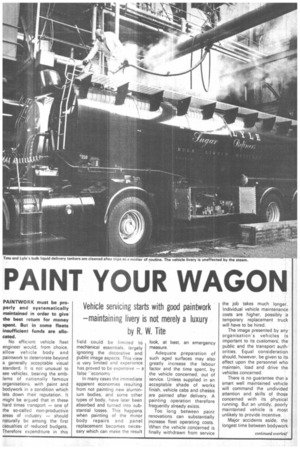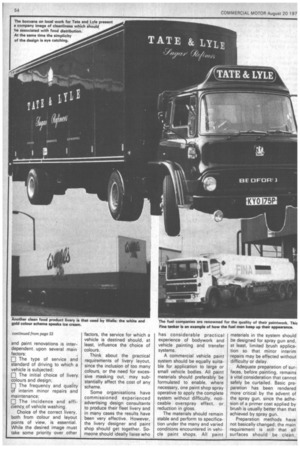PAINT YOUR WAGON
Page 55

Page 56

Page 57

If you've noticed an error in this article please click here to report it so we can fix it.
Vehicle servicing starts with good paintwork —maintaining livery is not merely a luxury by R. W. Tite
PAINTVVORK must be properly and systematically maintained in order to give' the best return for money spent. But in some fleets insufficient funds are allocated.
No efficient vehicle fleet engineer would, from choice, allow vehicle body and paintwork to deteriorate beyond a generally acceptable visual standard. It is not unusual to see vehicles, bearing the emblems of nationally famous organisations, with paint and bodywork in a condition which lets down their reputation. It might be argued that in these hard times transport — one of the so-called non-productive areas of industry — should naturally be among the first casualties of reduced budgets. Therefore expenditure in this field could be limited to mechanical essentials, largely ignoring the decorative and public image aspects. This view is very limited and experience has proved to be expensive — a false ''economy.
In many cases the immediate apparent economies resulting from not painting new aluminium bodies, and some other types of body, have later been absorbed and turned into substantial losses. This happens when painting of the minor body repairs and panel replacement becomes necessary which can make the result look, at best, an emergency measure..
Adequate preparation of such aged surfaces may also greatly increase the labour factor and the time spent, by the vehicle concerned, out of service. Unless supplied in an acceptable shade of works finish, vehicle cabs and chassis are painted after delivery. A painting operation therefore frequently already exists.
Too long between paint renovations can substantially increase fleet operating costs. When the vehicle concerned is finally withdrawn from service the job takes much longer. Individual vehicle maintenance costs are higher, possibly a temporary replacement truck will have to be hired.
The image presented by any organisation's vehicles is important to its customers, the public and the transport authorities. Equal consideration should, however, be given to its effect upon the personnel who maintain, load and drive the vehicles concerned.
There is no guarantee that a smart well maintained vehicle will command the undivided attention and skills of those concerned with its physical running. But an untidy, poorly maintained vehicle is most unlikely to provide incentive.
Major accidents aside, the longest time between bodywork
and paint renovations is interdependent. upon several main .factors:
The type of service and standard of driving to which a vehicle is subjected; LI The initial choice of livery colours and design: 111 The frequency and quality of interim minor repairs and maintenance; 0 The incidence and efficiency of vehicle washing.
Choice of the correct livery, both from colour and layout points of view, is essential. While the desired image must take some priority over other factors, the service for which a vehicle is destined should, at least, influence the choice of colours.
Think about the practical requirements of livery layout, since the inclusion of too many colours, or the need for excessive masking out, may substantially affect the cost of any scheme.
Some organisations have commissioned experienced advertising design consultants to produce their fleet livery and in many cases the results have been very effective. However, the livery designer and paint shop should get together. Someone should ideally liaise who has considerable practical experience of bodywork and vehicle painting and transfer systems.
A commercial vehicle paint system should be equally suitable for application to large or small vehicle bodies. All paint materials should preferably be formulated to enable, where necessary, one paint shop spray operative to apply the complete system without difficulty, noticeable overspray effect, or reduction in gloss.
The materials should remain stable and perform to specification under the many and varied conditions encountered in vehicle paint shops. All paint materials in the system should he designed for spray gun and, at least, limited brush application so that minor interim repairs may be effected without difficulty or delay.
Adequate preparation of surfaces, before painting, remains a vital consideration that cannot safely be curtailed. Basic preparation has been rendered more critical by the advent of the spray gun, since the adhesion of a primer coat applied by brush is usually better than that achieved by spray gun.
Preparation methods have not basically changed; the main requirement is still that all surfaces should be clean, grease free and properly flatted or keyed, prior to priming. Staved works primers and finishes should certainly be well keyed before re-coating takes place.
For steel, the most acceptable system is, of course, to shot blast and then prime as immediately afterwards as possible. However, in most cases the facilities for this procedure are not available and the normal process is to remove rust and scale, so far as possible, with a wire brush or coarse sanding disc, finishing by de-greasing and cleaning with solvent or a recommended chemical solution.
Although it is unwise to attempt economies at the expense of surface preparation, before painting, developments in commercial vehicle paint systems have considerably (-educed the work. In certain circumstances undercoats may now be omitted.
Bare aluminium, and some other non-ferrous materials used in vehicle body construction may be primed vvith materials which, when dry, can be directly overcoated with the final finish coat, thus omitting the undercoat, a flatting operation and, possibly, slightly reducing the quantity of paint materials used.
Improvements in the opacity, colour stability and gloss Factors of paint finishes have 311110St eliminated the need for varnishing. Frequently the type Df paint system described here can allow both primer and final coat to be applied in one day, since such primers are normally available in a limited range of Dasic colours which should provide a sympathetic background :0 the normal standard range of Finishing shades.
The use of the pre-masked type of transfer in conjunction with such a paint scheme can often result in a complete vehicle livery being applied in one day. Surface preparation, the removal and re-assemly of vehicle fittings and other final detail work do of course, need more time.
High-gloss finish and rapid drying are both very desirable qualities, but they can unfortunately, become almost inversely proportional to each other where the painting of medium to large vehicles is to be considered. A compromise which maintains a reasonably high standard of finish, without extending the drying time beyond an acceptable practical limit, is perhaps what is most needed.
A marginal improvement in drying time at the expense of quality of finish is a questionable asset. Quicker drying facilitates earlier tape masking, but in many cases the day after a final finish coat has been applied is occupied with the touching in of semi-accessible areas such as door shuts, together with the re-assembly of fittings. But with normal programming, the masking out, application and surface drying of a second colour can be done before the final details are attended to.
In exceptional cases where speed is the priority, the sacrifice of finish coat quality may be acceptable. Generally speaking, however, the fleet engineer expects a newly painted or re-painted vehicle to display his company's image to full advantage. A high degree of finish is an important factor in this respect.
Prevention is normally less expensive than cure. Some initial practical study of a body design, and the conditions under which it will have to operate, may later be repaid with interest in the form of maintenance savings.
These would come through the elimination of the repetitive type of minor repair usually arising from simple design faults. Routine maintenance, enabling minor accident damage and paint work blemishes to be attended to, should take place at regular intervals. These would prefera-• bly occur when a vehicle is withdrawn from service for normal mechanical attention.
Unfortunately, even fleet operators with their own repair and paint shop facilities, may experience difficulties in coordinating the activities of the different departments involved.




































































































